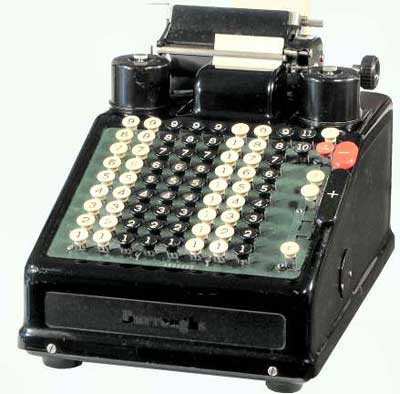
3 Facts About The Burroughs Adding Machine
- The Burroughs Adding Machine can still be purchased today from sites like eBay, usually for between $70 and $300, or more depending on the condition of the machine.
- At one point the Burroughs Adding Machine Company had around ninety percent of the calculator market. The company made a habit of buying other companies before they had a chance to become real competition.
- There were almost sixty variants of the Burroughs Adding Machine.

Burroughs Adding Machine History
The Burroughs Adding Machine was invented by one William Seward Burroughs in the late 1800s as a solution to a common issue he faced: having to tirelessly count numbers at his bank job. William Burroughs was pursuing a job as a bank clerk per his father’s wishes after a rather short education, and this is where he faced a problem that required solving. However, William’s childhood was spent with his father, a mechanic, and he grew to love inventing. Between William’s distaste for banking and his love for inventing, he decided to create an adding machine to solve the problem he and his colleagues regularly faced at work.

After about five years of working for the bank, Burroughs took a job at a machine shop where he finally had access to the tools and equipment necessary to build a viable solution to his problem, as well as like-minded individuals with the skills and ability to teach him how to make such items. One such inventor was Frank Baldwin who also invented another type of calculator. Burroughs built his machines with immaculate attention to detail, using precision tools and parts at every opportunity. It wasn’t long into William’s career as a machinist that he left his first shop in search of a smaller location that would allow him to pursue his own creative projects. This move would introduce him to Joseph Boyer, who would later become instrumental in the development of his adding machine. In 1884 the first prototype of the Burroughs Adding Machine was ready. Just a year later William Burroughs applied for a patent for his machine. Three years after that application was submitted, the patent was granted. The initial release of the new Adding Machine had a value of $475, and was not without issue, as many users complained the components were too sensitive and produced different results based on how much pressure was applied to the parts.
Quick Facts
- Created
- The Burroughs Adding Machine was invented in the early 1880’s, and the official patent was granted in 1888.
- Creator (person)
- William Seward Burroughs.
- Original Use
- The Burroughs Adding Machine was used for the basic adding and listing of numbers.
- Cost
- The first Burroughs Adding Machine cost $475 in 1890.

Despite the issues with the first release of the adding machine, a company, and later an enterprise was formed from this invention. By 1906 the Burroughs Adding Machine Company owned an estimated ninety percent of the calculator market. William’s company achieved this monopoly by acquiring any potential competitors before they could make any significant impact on the market.

Burroughs Adding Machine: How It Worked
There have been several variations of the Burroughs Adding Machine built and sold over time that were distinguished between classes. The Class 1 design has just one adding mechanism, whereas Class 2 has two. The Class 3 machine design was based on an earlier design in which the user could not see the numbers until after the calculation was complete. Because of this design, the Class 3 machine was referred to as “blind”. There were also Class 4, 5, 6, and 7 machines. The main differences between the classes were the capabilities. Some calculators could add, subtract, and multiply, and some would display the number while calculating whereas others would not. There was also a portable version of the machine, called Series P (for portable). More functionality (and whether it was portable) determined the number of parts used and the value of the machine, and at one point there were close to sixty models available. There was something for everyone.

Burroughs Adding Machine: Historical Significance
The Adding Machine was not the first calculator, but it was the first mainstream calculator to essentially take over almost the entire market. Not only that, but the Burroughs Adding Machine was more than just a product, it was a line of products developed to fit the customer’s needs. People who needed a simple counting machine for their shop had several options, as did the individual who needed a portable calculator. The Burroughs Adding Machine eventually became an antique item, and people buy and sell them on eBay and other sites. Individuals can match the serial numbers on their machine to a timeline to determine when their machine was built, which impacts the overall value.



